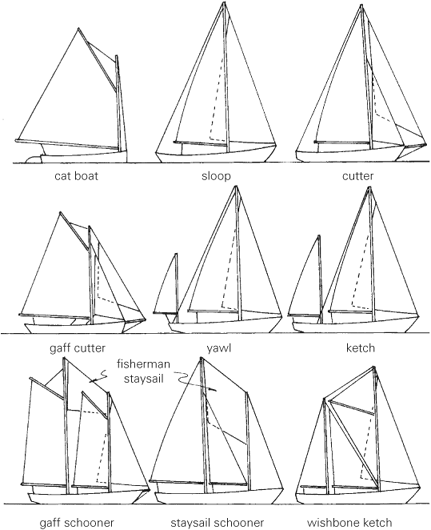Different Sailboats: Sail Positions and Interaction
The more traditional, stereotypical sailboats have a single sail (the mainsail), but most sailboats actually have two or more. Larger sails generally become a problem after a certain point because the mast can't support the weight of such a large sail (conversely, the large mast necessary to support a sail of that size probably couldn't be supported by the ship itself); this problem is solved by simply adding more small sails spread along the length of the ship instead of one large one near the center. Different ships have different types and numbers of sails, where the position of the first sail affects the air currents leading to the next sail, which affects the air currents to the next, and so on.
The speed of the sailboat can be increased by decreasing the size of the air stream between the leech (edge) of the jib and the mast. Additionally, having the correct distance between the jib and the mainsail keeps the airflow constant and increases the efficiency of both sails by decreasing the amount that the sails luff (lose air and start flapping).
The speed of the sailboat can be increased by decreasing the size of the air stream between the leech (edge) of the jib and the mast. Additionally, having the correct distance between the jib and the mainsail keeps the airflow constant and increases the efficiency of both sails by decreasing the amount that the sails luff (lose air and start flapping).
|
1. Masthead sloop: The jib is on the masthead with the mainsail; this causes the boat to heel less and allows the ship to have a shorter mainsail while getting approximately the same amount of power.
2. Marconi/Bermudan cutter: The headsail is split into two different sails (jib and staysail) with the mainsail behind them both. This allows a greater variety in changing the trim and shape of the sails for greater adaptability to the wind, as well as increasing the maneuvering capabilities of the ship. 3. Ketch and Yawl: These are two different kinds of ships in their own right, but they both have the main mast with the jib and mainsail in addition to a second mizzen mast at the back of the ship that holds a much smaller mizzen sail. The mizzen mast is good for mostly balance, but it can also add to the thrust when the ship is between running and close reaching. 4.Schooner: This is a very large ship that has multiple sails, all of which change the air current for the following sails. These sails include the flying jib, the jib, staysail, foresail, and the mainsail. |
